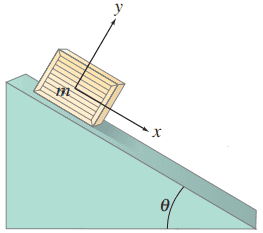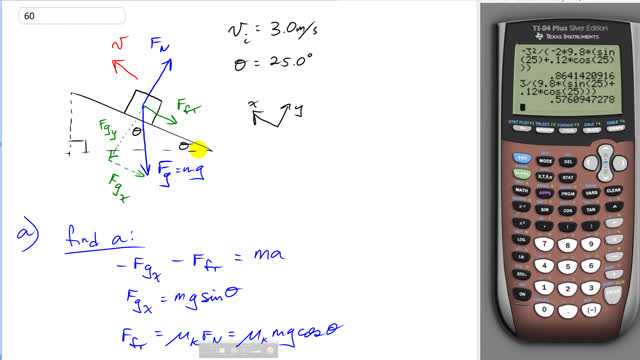
A crate is given an initial speed of 3.0 m/s up the plane shown in Fig. 4–60.
- How far up the plane will it go?
- How much time elapses before it returns to its starting point? Assume .


In order to watch this solution you need to have a subscription.
This is Giancoli Answers with Mr. Dychko. This box has given an initial velocity up the ramp of three meters per second. And the ramp is inclined at 25 degrees and our job is to figure out how high it'll go. But to figure that out we'll need to know what the acceleration is of the box, it's slowing down because it has both, the friction pointing down the ramp and the component of gravity along the ramp is also down the ramp. And so, those together resulting in a net force as shown here. And the net force equals mass times acceleration. So, we'll figure out the acceleration, and given this initial speed, determine how far it'll go using this kinematics formula. So, we're taking x to be positive up the ramp, and that means the component of gravity along the ramp is negative and friction also is negative because friction is directed down the ramp since it opposes the direction of motion, that's kinetic friction there. And Fgx is mg sine theta because it's the opposite leg of this gravity triangle here, and so we use sine theta to get it and multiply it by the force of gravity, mg. And force of friction is the coefficient of kinetic friction times the normal force. And since there's no acceleration perpendicular to the ramp, the normal force has to equal this component of gravity perpendicular to the ramp, the y component of gravity, and that is mg cos theta because it's the adjacent leg of the triangle. So, we have mg cos theta there for the normal force. And then times by coefficient of kinetic friction to get the friction force. So, I'm substituting into this formula now. So, Fgx is mg sine theta and force of friction is muK mg cos theta, and all that equals ma. And we'll solve for a by dividing both sides by m and then switching the sides around. And we get a is negative g which I factored out, times sine theta plus muK cos theta. And we could get a number there but instead I'm just gonna carry on with algebra here and then we're putting some numbers for acceleration down there. So, we have final velocity squared equals initial velocity squared plus 2ad, and we just figured out a. We know that VF is zero because that's the speed it'll have when it gets to the maximum distance up above along the ramp. And we'll subtract Vi squared from both sides. And then divide both sides by 2a. And we'll get the displacement up the ramp is negative V initial squared divided by 2 times acceleration. And then we substitute for the acceleration from there and put it here. And so that brings all along a negative g with it and sine theta plus muK cos theta. And so, our displacement will be negative of 3 meters per second and we square that, divided by a negative 2 times 9.8 times sine 25 plus 0.12 times cos 25. And we get 0.86 meters is the displacement up above up the ramp it'll go before it comes to a stop. And that's positive as we expect since positive is in the direction of the ramp. In part B, the total time it takes to go up and then back down to a starting point. And since there's friction, the time it takes to go up the ramp will not be equal to the time it takes to go down the ramp. So, you can't just simply go tup times 2. And the reason for that is that the accelerations are different in the two legs of the trip. When the box is going up the ramp, the acceleration is a result of the x component of gravity and the friction, both going in the same direction. And then when the box is going down the ramp, friction being the way it is, kinetic friction always it's opposing the direction of motion, the friction is going to go up. Whereas gravity is still going down there ramp. And so, friction and gravity are working against each other when the box goes down the ramp and so has a different acceleration and so it'll take a different amount of time to travel the same distance. So, the time to go up will be final speed equals initial speed plus acceleration up times time and we already figured out the acceleration going up the ramp up here. And so, we have, get rid of the negatives, they cancel there. So, we have 3 meters per second divided by 9.8 meters per second squared times sine 25 plus 0.12, times cos 25, and we get 0.57609 seconds to go up the ramp. And then to go down the ramp, friction is going up the ramp whereas gravity's going down. So, friction is now positive and gravity x component is negative, and that equals mass times acceleration down the ramp and just quickly substituting for the friction in the x component of gravity here. So, friction is a coefficient of kinetic friction times mg cos theta because that gives us Fgy which is equal to FN. And then we have minus mg sine theta. Sine because it's the opposite leg of that triangle, and that equals ma down. And so, cancel the m's, and you get that acceleration is g times muK cos theta minus sine theta. Plug in some numbers, and we have 9.8 times 0.12 times cos 25 minus sine 25. And we get an acceleration of negative 3.0758 meters per second squared. And we expected a negative because we've chosen x to be positive up the ramp whereas the box is accelerating down the ramp right now, and so, we expected the acceleration to be in this direction which is the negative direction now. And the displacement equals 1/2 at squared. There's no initial speed, initial speed is zero, we're considering the moment where it just is at the top of its trajectory up the ramp here and then it stops and then it turns around, and so, it begins its trip down the ramp with initial velocity of zero. So, that's why there's no Vit term here. And so, we just have displacement equals 1/2 a down t down squared. And we can multiply both sides by 2 over... Well, let's, yeah. Let's go... That's a little bit backwards there, isn't it? We're gonna have to fix that. So, we have 2 over acceleration down is what we have to multiply both sides by here. And so, that gives 2 times displacement divided by acceleration. So, we have 2 times, how far did it go? It went 0.86414. And then the acceleration down is negative 3.0758 meters per second squared. Now, before we have our calculator blow up by trying to take the square root of a negative, let's realize that this displacement is down the ramp, and that's the negative direction. So, that displacement is a negative. Right there. So, we have square root of 2 times... I'll just go answer and that, 'cause that's the 3.07. Well, sorry, my mistake. Negative 0.86414 divided by that answer. And that gives t down is 0.74959 seconds. So, the total time is the time up plus the time down. And we expected the time down to take it longer because we have these forces working against each other. So, the acceleration is less, less magnitude. Whereas here the forces are working in the same direction. So, the acceleration is greater magnitude. And so, the trip down should take longer since acceleration is smaller. And sure enough that's the case. So, we have 0.57609 seconds up plus 0.74959 seconds down, and that equals... That equals 1.3 seconds. Is that how many significant figures we should have? Yeah, I think so. We're given 3.0 for initial speed, so, there we go. 1.3 seconds to go round trip.
If the box is moving up and my positive x component is to the right. Then the Fgx would be going up?
Hi suriyak786, thanks for this question. The direction of gravity is unaffected by the direction of motion of the box, and it's also unaffected by the coordinate system (whether right is positive or negative). The component of gravity along the ramp will always point down the ramp. Whether that component gets a negative or positive sign is determined by your personal choice of coordinate system (whether "right" is positive or negative, in other words), but the arrow will always point down the ramp.
Hope that helps,
Mr. Dychko